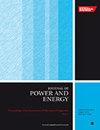跨声速涡轮翼型极限载荷的非定常效应表征
IF 1.1
4区 工程技术
Q3 ENGINEERING, MECHANICAL
Proceedings of the Institution of Mechanical Engineers, Part A: Journal of Power and Energy
Pub Date : 2023-08-18
DOI:10.1177/09576509231196268
引用次数: 0
摘要
为了更好地理解旋涡脱落对翼型极限加载时尾缘激波系统性质的影响,对某跨声速涡轮翼型在亚极限、极限和超临界条件下的计算流体动力学进行了研究。采用稳态RANS、非定常RANS、DDES和无湍流模型四种建模策略。除临界加载时的URANS模型外,瞬态建模方法对预测质量-流量平均总压损失系数、质量-流量平均流动角和极限加载压力比的影响均不显著。研究发现,URANS建模方法无法预测从近尾缘主导涡形成到基压涡形成的转变,导致预测的总压损失急剧上升。除了后缘基压区和沿吸力面激波冲击点外,所有建模策略的表面等熵马赫分布预测都相似。对后缘的边界层状态进行了详细的回顾。结果表明,所有模拟方法均能预测沿压力面尾缘的层流边界层廓线和沿吸力面的湍流廓线。对预测的基压分布进行了回顾,表明基压随压力比的增大而减小。非定常模拟方法预测的平均表面压力始终低于稳态RANS模拟。数值纹影轮廓的定性图像显示了涡旋形状、大小和随后的激波影响预测的巨大差异。本文章由计算机程序翻译,如有差异,请以英文原文为准。
A characterization of unsteady effects for transonic turbine airfoil limit loading
To better understand the effect of vortex shedding on the nature of the trailing edge shock system during airfoil limit loading a computational fluid dynamic investigation was performed for a transonic turbine airfoil at sublimit, limit and supercritical conditions. Four modeling strategies were employed: steady state RANS, unsteady RANS, DDES, and turbulence model free. The influence of transient modeling approaches on the predicted mass-flow averaged total pressure loss coefficient, mass-flow averaged flow angles, and on the limit loading pressure ratio were found to be insignificant with the exception of the URANS model during critical loading. It was found that the URANS modeling approach failed to predict the transition from near trailing edge dominated vortex formation to base pressure vortex formation resulting in a drastic rise in predicted total pressure loss. Surface isentropic Mach distributions were predicted similarly for all modeling strategies, with the exception of the trailing edge base pressure region and points of shock impingement along the suction surface. A detailed review of the boundary layer states at the trailing edge was performed. It was found that all of the modeling approaches predicted laminar boundary layer profiles along the pressure surface trailing edge and turbulent profiles along the suction surface. The predicted base pressure distributions were also reviewed, showing the base pressure to decrease with increasing pressure ratio. The unsteady simulation approaches consistently predicted lower average surface pressures than the steady state RANS simulations. Qualitative images of the numerical Schlieren contours were presented and reviewed showing large differences in the prediction of vortex shape, size, and subsequent shock influence.
求助全文
通过发布文献求助,成功后即可免费获取论文全文。
去求助
来源期刊

CiteScore
3.30
自引率
5.90%
发文量
114
审稿时长
5.4 months
期刊介绍:
The Journal of Power and Energy, Part A of the Proceedings of the Institution of Mechanical Engineers, is dedicated to publishing peer-reviewed papers of high scientific quality on all aspects of the technology of energy conversion systems.
 求助内容:
求助内容: 应助结果提醒方式:
应助结果提醒方式:


